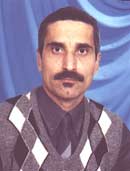Contents: 2024 | 2023 | 2022 | 2021 | 2020 | 2019 | 2018 | 2017 | 2016 | 2015 | 2014 | 2013 | 2012 | 2011 | 2010 | 2009 | 2008 | 2007 | 2006 | 2005 | 2004 | 2003 | 2002 | 2001
2004, 2
Application of artificial neural networks to identify the premature ventricular contraction (PVC) beats
language: English
received 15.12.2003, published 24.03.2004
Download article (PDF, 200 kb, ZIP), use browser command "Save Target As..."
To read this document you need Adobe Acrobat © Reader software, which is simple to use and available at no cost. Use version 4.0 or higher. You can download software from Adobe site (http://www.adobe.com/).
ABSTRACT
Premature ventricular contraction (PVC) is a cardiac arrhythmia that can result in sudden death. Understanding and treatment of this disorder would be improved if patterns of electrical activation could be accurately identified and studied during its occurrence. In this paper, we shall review three feature extractions algorithms of the electrocardiogram (ECG) signal, Fourier transform, linear prediction coding (LPC) technique and principal component analysis (PCA) method, with aim of generating the most appropriate input vector for a neural classifier. The performance measures of the classifier rate, sensitivity and specificity of these algorithms will also be presented using as training and testing data sets from the MIT-BIH (Massachusetts Institute Technology – Beth Israel Hospital) database.
14 pages, 3 figures
Сitation: M. A. Chikh, F. Bereksi Reguig. Application of artificial neural networks to identify the premature ventricular contraction (PVC) beats. Electronic Journal “Technical Acoustics”, http://www.ejta.org, 2004, 2.
REFERENCES
[1] M. Hamdan, M. Scheinman. Current approaches in patients with ventricular tachyarrhythmias. Med. Clin. North Am., vol. 79, pp. 1097–1120, 1995.
[2] D. Tchaporia, P. B. Snow, R. J. Almassy, W. J. Oetgen. Artificial neural networks: current status in cardiovascular medicine. J. Am. Col. Cardiol., vol. 28, pp. 515–523, 1996.
[3] R. Mark, G. Moody. MIT-BIH arrhythmia database directory. Massachusetts Inst. of Tech. (M.I.T), 1988.
[4] G. Moody. ECG database programmer’s guide. Massachusetts Inst. of Tech. (M.I.T), Division of Health Science and Technology, 1989.
[5] P. A. Lynn. Recursive digital filters for biological signals. Med. & Biol. Eng., vol. 9, pp. 37–44, 1971.
[6] P. A. Lynn. Online digital filters for biological signals: some fast design for a small computer. Med. & Biol. Eng. & Comput., vol. 15, pp. 534–540, 1977.
[7] P. A. Lynn. . Transversal resonator digital filters: fast and flexible online processors for biological signals. Med.Biol.Comput, vol. 21, pp. 718–730, 1983.
[8] N. V. Thakor, D. Moreau. Design and analysis of quantized coefficient digital filters: application to biomedical signal processing with microprocessors, Med. & Biol. Eng. & Comput., vol. 25, pp. 18–25, 1987.
[9] R. Wariar and D. Moreau. Integer coefficient bandpass filter for the simultaneous removal of baseline wander, 50 and 100 Hz interference from the ECG. Med. & Biol. Eng. & Comput., vol. 29, pp. 333–336, 1991.
[10] R. A. Balda, G. Diller, et al, The HP ECG Analysis Program. Trends in Computer Processing Electrocardiograms. North-Holland, Amsterdam, pp. 197–204, 1977.
[11] Special Issue on the CSE Project (Common Standards for Quantitative Electrocardiography), Methods of information in Medicine, vol. 20, 1990.
[12] G. Bortlan, J. L. Willems. Diagnostic ECG classification based on neural networks. J. Electrocardiology, vol. 26, pp. 75–79, 1994.
[13] R. Silipo, M. Gori, C. Marchesi. Classification of arrhythmic events in ambulatory ECG, using artificial neural networks. Computers and Biomedical Research, vol. 28 pp. 305–318, 1995.
[14] N. H. Hu, S. Palreddy, W. J. Tompkins. A patient adaptable ECG beat classifier using a mixture of experts approach. IEEE Trans. Biomed. Eng., vol. 44, N°9, pp. 891–900, Sept. 1997.
[15] S. Barro, R. Ruiz, D. Cabello and J. Mira. Algorithmic sequential decision making in the frequency domaine for life threating ventricular arrhythmias and initiative artefacts: A diagnostic system. J Biomed. Eng., vol. 11, pp. 320–328, 1989.
[16] K. Minami, Y. Ohknma, H. Nakajuma, T. Tohoshima. Real-time ventricular arrhythmia detection with Fourier analysis and neural network. Proc. Computer in Cardiology, pp. 545–548, 1996.
[17] T.Stamkopoulos, K. Diamantaras, N. Maglaveras, M. Strintzis. ECG analysis using nonlinear PCA neural networks for ischemia detection. IEEE Trans. on signal processing, vol. 46, N°11, pp. 3058–3067, Nov. 1998.
[18] L. Biel, O. Pettersson, L. Philipson, P. Wide. ECG analysis: A new approach in human identification. IEEE Trans. on instrumentation and measurement, vol. 50, N°3, pp. 808–812, 2001.
[19] K. P. Lin, W. H. Chang. QRS feature extraction using linear prediction. IEEE Trans. Biomed. Eng., vol. 36, N°10, pp. 1050–1055, Oct. 1989.
[20] Y Suzuki. Self-organizing QRS-wave recognition in ECG using neural networks. IEEE Trans. on neural networks, vol. 6, N°10, pp. 1469–1477, 1995.
[21] Ham F. M., Han S. Classification of cardiac arrhythmias using fuzzy A. IEEE Trans. Biomed. Eng., vol. 43, N°4, pp. 425–430, April 1996.
[22] Chikh M. A. N. Belgacem, F. Bereksi-Reguig. Neural classifier to classify ectopic beats. Acte des IX emes rencontre de la Societe Francophone de Classification, Toulouse, le 16–18 Septembre 2002.
[23] Chikh M. A., N. Belgacem, F. Brereksi-Reguig. A PVC beat identification using Fourier spectrum. Acte de 9 conference internationale sur le traitement neuronale de l’information (ICONIP’02), Singapore, 18-22 Novenmbre 2002.
 |
Mohammed Amine Chikh received the engineering degree in Computer Science from the National Institute of electricity and electronics of Boumerdes, Algeria in 1985 and the Master degree in Physic Electronics from the University of Tlemcen, Algeria in 1992. Currently, he is preparing a PHD at the University of Tlemcen, Algeria and he is a member of Laboratory in Biomedical Engineering. His area of research interests includes Biomedical signal Processing and classification of pathologies. e-mails: c_bamine(at)yahoo.fr, mea_chikh(at)mail.univ-tlemcen.dz |
|
 |
F. Bereksi Reguig recieved the engineering degree in Electronics from the University of Science and Technology, Oran, Algeria in 1983 and the MSc and PhD degrees in Modern Electronics from the University of Nottingham, England in 1985 and 1989 respectively. Currently, he is a Professor in the Department of Electronics at the University of Tlemcen, Algeria and the Director of the research Laboratory in Biomedical Engineering. His area of research interests includes biomedical signal processing and microcomputer-based medical instrumentation. |
|
